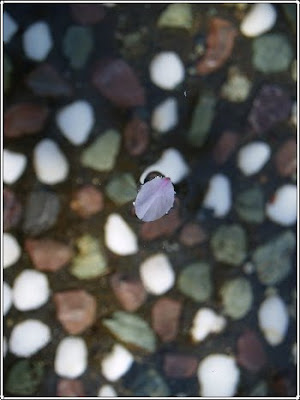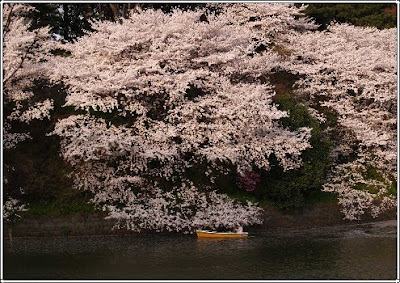The Short, Happy Life of the Cherry Blossom
Shikishima no
Yamato-gokoro wo
Hito-towaba,
Asahi ni niou
Yamazakura bana.
(If one should ask you concerning the heart of a true Japanese, point to the wild cherry flower glowing in the sun.)
-- Norinaga Motoori (1730-1801)
Cherry blossoms, called sakura in Japanese, are taken very seriously in Japan. Any tourist or long-term visitor can easily notice this whatever time of the year they arrive. Sakura can be seen everywhere -- art, tea cups, TV commercials, wrapping paper, and so on.
The Great Buddha of Kamakura with cherry blossoms
The official flower of the Japanese imperial family is the stately (and hard-to-pronounce) chrysanthemum. The unofficial national flower is the cherry blossom. Of all the flowers and blossoms in Japan only the cherry blossom can bring the country to a halt: Japanese drop whatever they are doing to rush and grab a blue tarp mat so they can sit under the blossoms.
Every spring, the Japanese wait eagerly with an anticipation that borders on mania for the first blooming of the cherry blossoms. They have been doing this for well over a thousand years.
Enjoying a cherry blossom "snowfall"
Flowers and blossoms are revered to such a degree in Japan that blooming times are duly noted on calendars and Japanese often plan their vacations around them.
The blooming of the cherry blossom is the most important and the most widely celebrated. In spring, cherry trees barren from winter's cold grip suddenly burst forth into color and transform the landscape into a fairy tale-like wonder world.
Ogaki Castle defended by a row of cherry trees.
Even bleak urban centers become almost welcoming under a canopy of pink and white and sometimes yellow blossoms. Cherry blossoms accentuate traditional places such as shrines, temples and castles to their fullest glory. Samurai warlords often went to great lengths to beautify their castles, built for defense, with gardens, fish ponds, and cherry trees.
A lone blossom petal floats upon the water of a shrine's purification basin.
The samurai warriors of Old Japan came to take the cherry blossom as their spiritual motif. They saw in the beautiful but brief life of the sakura their own fate. The sakura falls at the height of its beauty rather than withering away. This "death" is much in the same way the samurai wished to die: In the war-torn period of Japan many samurai, like the blossoms, fell at the height of their youth and glory long before reaching old age.
Enjoying the blossoms with just a few thousand others.
Nighttime finds the Japanese gathered under the blossoms to drink, eat, and be merry as they have done for generations. Hanami (cherry blossom viewing parties) is a tradition that goes back to at least the Nara Period (710-784). Hanami was originally an aspect of Chinese influence, but it was the early-blooming plum blossoms that were honored. In the following period known as the Heien (794-1185), the cherry blossom won the attention of the Japanese and the word hanami came to be associated with cherry blossoms.
At first hanami was mainly the pastime of aristocrats but over time the practice spread to people of all walks of life. Hanami celebrants of the past enjoyed poetry games in which contestants tried to come up with new stanzas to continue a poem. Nowadays, for better or worse, portable karoake machines tend to take the place of poetry.
Food stalls selling all manner of Japanese cuisine are a common feature wherever the cherry blossoms are the thickest. Popular food items are okonomiyaki, a Japanese-type pancake of seafood and noodles, takoyaki, breaded balls containing octopus tentacle, yaki-tori, skewered chicken strips, and of course sushi.
An old cherry tree in Kyoto
The blooming season is brief -- too brief for the masses of overworked office workers. The peak period is a time for fleeing the shackles of the office.
Popular cherry blossom viewing spots are crammed with people, food vendors, and blue mats. Inebriated viewers often have a difficult time navigating themselves back to their party through a sea of hanami participants. Companies will book places in advance for their staff parties and send out rookie employees to guard the mats and alcohol during the day.
Clouds of cherry blossoms! / Is that temple bell in Ueno or Asakusa? -- Basho (17th Century)
With the arrival of Western visitors en masse to Japan in the late 19th century following the end of over two centuries of isolation, the Japanese mania for cherry blossoms every spring was viewed with some wry amusement. Certain visitors, who were more practical and with a mind for productivity, just could not see the attraction to trees that, while beautiful, did not bear fruit that could be eaten or sold. The cherry blossom was called by one such visitor as an aristocrat among flowers: not working but wanting to be admired for its beauty.
Boating under the cherry blossoms at Chidorigafuchi, Tokyo.
This view has changed and nowadays visitors together with the Japanese rush around to see the cherry blossom anywhere it blooms and admire its brief but beautiful life.
If there were no cherry blossoms in this world / How much more tranquil our hearts would be in spring. -- Ariwara no Narihira (10th Century)
TIME: Blooming varies but for much of Japan sakura blooms late March through early April. In Tohoku a popular spot is Hirosaki Castle which blooms in late April to early May
NOTE: There is no official "Cherry Blossom Festival" despite a number of people there is. Events (if any) vary from region to region. Most people just do hanami - sitting under the blossoms while eating and drinking.










No comments:
Post a Comment